Sometimes When The Curtains Are Open, We Wave At Each Other
Commissioned by Liminal Magazine 2022
Development by Nicole Ho
We invite you to use a screen reader to engage with the alt text descriptions. Alternatively, seek written alt text by inspecting the HTML code of this page.
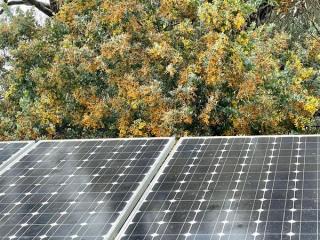
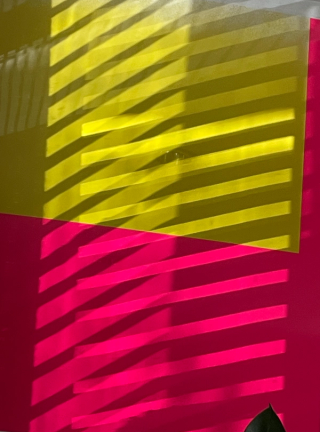

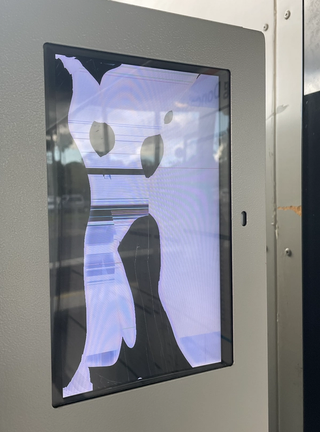
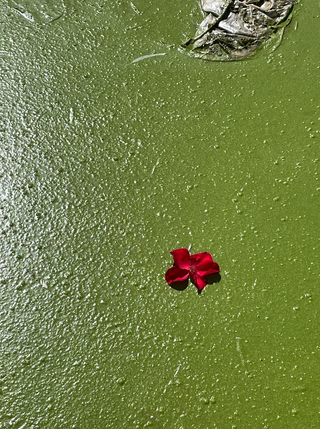

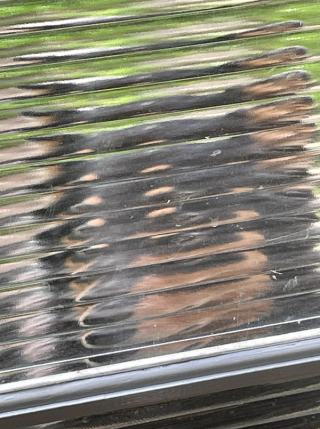

Conversation
One…
Two…
Three…
CLAP
There’s an AI in the meeting, it doesn’t like my shy voice.
* * *
I find that this practice of ekphrastic description provides a pause.
It introduces processes of attention.
To quietly rest—alone or together—with an artwork, to describe perceptions of the work in one’s own words, or through shared words, has the ability to uncover layers which are kind of hidden...
I found that the descriptive process has this grounding quality, that (as you said) gifts us a moment for reflection, a moment to uncover layers that maybe we have difficulty engaging with in everyday experience.
... an antidote to restlessness, to the pace of consumption of imagery ...
* * *
Description is an inexact art.
* * *
I think about description as refraction.
So we have reflection and refraction?
This makes me think of the dam that I walk around each night, here on Djaara Country. Reflection of the transiting clouds, the rising moon, the sunset. Refraction as the stems of bulrushes optically shift across the threshold of the water surface.
To walk the metaphor further: the act of perception feels like reflection of the rays of light off the surface of the dam, a momentary interpretation of a transient image. The act of description feels like refraction, a shift and scattering.
And what about the texts that we keep citing, that we have been sharing with one another?
Maybe that’s like the medium, the substance, through which refraction takes place?
For the dam, the medium would be mud and decomposing leaf litter and tannins from the eucalypts.
Cited texts as decomposing leaf litter, as clouds of swirling mud, as tannins?
Yes,
approximately.
* * *
In creating conditions for ekphrasis (offering methods, framing contexts, drafting scores for encounter, protecting dates and durations for pause, navigating architectures and artworks), how we can liberate the descriptive imagination?
* * *
One of the practices I’m drawn to is myopic reading, extreme close reading.
I think of myopic reading as a simple invitation, to suggest someone to move closer, whether to the weave of a canvas, the grain of a wooden frame, or the fibre of the page.
Descriptive pause resists the choreographies of image consumption that have become habit through scrolling social media. I’m very interested in peripheral attention.
How can we describe what is at the edges of our attention as we move past?
I’ve been thinking lately about conversation as resistance to legacies of disciplinary isolation, as a gentle refusal of the sensorial policing of bodies.
* * *
Why do you want to do this?
To have a conversation about ekphrastic description?
I’m drawn to publishing beyond the normative perceptual constraints, that habitually enclose frameworks of writing and design and reading.
* * *
I have an intermittent project, one-to-one to infinity, where I invite people to describe art exhibitions that an intimate acquaintance cannot see.
A strategy of using audio description beyond access blueprints. It was a way for me to encounter artworks during the lockdowns too: descriptive offerings from friends who could be there when I could not. Holding closely from a distance.
I think about publishing as this remarkable dual act, of reaching out to invite a reader into a conversation, and simultaneously, reaching out to an infinite audience of potential readers.
* * *
Tell me about the photo you sent me as we began this exchange, it looked like collages of fabric and words overlaid?
Yes, it is a quilt I made from fabrics I found in my grandparents’ linen cupboard. The text is a heated vinyl transfer in light sky blue colour. Its text reads:
“The weight of their consciousness rests heavy. Towards the depths until a linear clear grey sky. A background of blank motionless water graduating in darkness.”
In making the quilt I wanted to see how ekphrastic description could be imagined in a new context. The images I describe are digital reproductions of Barbara Visser’s photographic poster series titled The World Belongs To Early Risers. In the process of making a quilt it creates a material representation of my description.
It becomes tactile and the words take on new meaning in their new ‘material’ context, when they are completely out of context and have little relation to the original digital reproductions of Visser’s photographs. I see this as an interesting way of referencing, translating meaning from one material to another, mirroring in a sense—an interesting method to use as a maker I am finding.
Let’s close with that, so we can circle back to the beginning.
Reflection
I’m sitting in my study with an off-white background. It is a wall I painted in Dulux Antique White U.S.A. matte.
The study where I sit lays its foundations on Woiwurrung Country. This study was my grandfather’s study, and this is his house. He built it when he was 29, about 60 years ago.
When I work here I feel closer to him. Today I’m wearing a white hat with yellow, blue, red and green stitching. There is soft filtered light on the left hand side of my face; the light peers through natural linen curtains which are partially open. Beyond that, over an old fence I can see my neighbour’s window. Her curtains are closed today. Sometimes when the curtains are open, we wave at each other. She is 105 years old and has become deaf later in life.
We sometimes go over and take a cake to share over a cup of tea. We communicate by using handheld whiteboards. We shorten our sentences when writing so they fit on the boards. She laughs in acknowledgement of the conversation’s tangents. She is a really happy person. I asked her once what the secret was, and she replied, “I had a younger husband and I don’t read or watch the news.”
We bond over Gardening Australia, a show on ABC TV. It’s her favourite. Her son lives with her now and is her full-time carer. I think they like that we live here. When we let him know that we are having people over, he responds happily and says “Good! Play music as loud as you like, Mum won’t mind.”
Right next to my leg on a mottled grey soft, lumpy bed my dog Honey is sleeping. She is a brown and naturally curly medium-sized dog, however since she was washed and blow-dried the other day, she is really fluffy; in her awkwardness we call her ‘Floof’. I was walking her earlier and someone stopped to pat her. They said she feels like a soft fluffy polyester blanket, like the ones they sell at K-Mart.
* * *
I am sitting in a bedroom home office in Djaara Country, and it’s cold and wet and damp today, even though it’s not raining. I have a window which is to my right, near a bookshelf which is loaded with the books that I’m working with at the moment.
And outside that window, the grass is really overgrown. It’s mostly a messy tangle of overhanging branches and weeds out there. But I don’t mind. I like the curtains open so I can tell that it’s not raining. At certain times of the year it’s really beautiful, when the roses are out and the bees are busy. In front of me is a soft light that I use because I like to work with the curtains drawn. The reason for that is that bright light tends to remove my vision.
And so I find it nice to be in the darkness. On the other side of the wall beside me is my son’s bedroom, which was inundated by a flood. We’ve been pulling up the carpet, exposing the flooring and underlay, and also pulling away the sodden mud brick of the wall, exposing the structure of the wall.
So at the moment, it’s funny, because it’s quite a beautiful cave-like sanctuary in my room, but I know beyond that wall, there’s chaos and disorder.
* * *
* * *
Thank you. Okay, well. So shall we stop the recording? Yeah, let’s do that.
Matter
They can, because they are seen to be able to.
They can, though they don’t look as if they can.1
“He only wanted to perform the unveiling in front of eyes of no consequence.” 2
* * *
“He could only half understand …
because he could only perceive half the ideas that were attached to the terms he was using...”3
* * *
“The errors to which sight is liable diminished its value in her eyes.
“I stand,” she said, “at the entrance of a long alley; and there is a certain object at its far end. One of my friends sees it moving, another sees it stationary; one says it is an animal, another that it is a man; and on approaching it, it turns out to be a tree-stump. No one can tell if the tower they see in the distance is round or square.”4
* * *
“I owe some of the most fantastical hallucinatory experiences of my childhood to my extreme nearsightedness:
Vanishing streets, substitutions, metaphorization and metonymization of the world and of people …”5
* * *
One day I said to her,
“Mademoiselle, imagine a cube.”
“I see it.”
“Place a point in the centre of the cube.”
“I have done so.”
“From the point draw straight lines to the angles; into what have you divided the cube?”
“Into six pyramids,” she replied without hesitation,
“Each having as its base one side of the cube, and a height equal to half its height.”
“True, but tell me where do you see this?”
“In my head, as you do.”6
* * *
"A beach of crystallised salt shimmering like snow under an evening sun, at the edge of a vast body of turquoise water.
A recent downpour had frozen the mountaintops, and their peaks were covered with white powder.
And down below, on the deep green mountain flanks, a few nomads were watching their yaks grazing."7
* * *
"... descriptive, rather than prescriptive vocabulary ..."8
Described as a ‘pictorial turn’ in his 1994 essay 'Picture Theory' W.J.T Mitchell submitted that the image is ‘the’ problem of the twentieth century and proposed ekphrasis as a method for social confrontation of power to combat ‘otherness’.9
* * *
"What does knowledge do—the pursuit of it, the having and exposing of it, the receiving again of knowledge of what one already knows?"10
"It’s less about amassing knowledge as it is exploring ways of knowing."11
* * *
"Poetry is the way we give name to the nameless so it can be thought."12
"Under certain circumstances, failing, losing, forgetting, unmaking, undoing, unbecoming, not knowing may in fact offer more creative, more cooperative, more surprising ways of being in the world."13
* * *
“... the concentration and the long struggle between sound sight sound and wide. And when it all came out so strangely.”14
Denis Diderot, ‘Letter on the Blind for the Use of Those who See’ (1749)
Ibid. [Writing of Reamur, the cataract surgeon]
Ibid. [Writing of Nicolas Saunders, the mathematician]
Denis Diderot, ‘Addition to the Letter’ (circa 1773), translated text in Margaret Jourdain, ‘Diderot’s Early Philosophical Works’ (1916)
Helene Cixous and Mireille Calle-Gruber. ‘Rootprints: Memory and Life Writing’ (1997)
Helene Cixous and Mireille Calle-Gruber. ‘Rootprints: Memory and Life Writing’ (1997)
Ibid.
Sabriye Tenberken, ‘My Path Leads to Tibet’ (2003) [Facing a rock]
Susan Sontag, ‘Against Interpretation’ (1964)
W.J.T Mitchell, ‘Pictorial Turn’ (1994)
Eve Kosofsky Sedgwick, Touching Feeling—Affect, Pedagogy, Performativity (2003)
Sarah Gory, ‘In Communion’ (2022)
Audre Lorde, ‘Poetry is Not a Luxury’ Chrysalis: A Magazine of Female Culture, no. 3 (1977)
Judith Halberstam, The Queer Art of Failure (2011)
Georgia Googer, ‘The Radical Ekphrasis Of Gertrude Stein's Tender Buttons’ (2018), Inscription to Donald Sutherland by Gertrude Stein on the inside cover of his copy of Tender Buttons (circa 1904)
Refraction
She looks at me with porcelain lips—a pinned brow welcome. A pleased dissatisfaction contours her face. Tight locks of hair shimmer through the glass. A disguise. “SUOXIC” she yells and I see a glimpse of her brown eyes through the grey filter of separation between us.
* * *
A hand with no sleeve points a pointy pick at a stunned gaze that is looking through the ‘center’ of my soul—piercing and pleading to read, to answer. An inquiry that sights a worrisome query, uncertain, the hand inquisitive to find.
* * *
A sky I cannot see—a constant murmuring, is it white noise? After a while it embeds itself with a sonic frequency that won’t wash off.
I look outside, a grey tinted glimpse of what is after it leaves me stranded and timeless. Besser block bricks and corrugations promising better transportation. Fluorescent blue white illuminates scatterings of both active and passive learnings and the aftermath of the activity. Illuminated eyes connect me and you, I remind myself to speak up
* * *
to
pause.
* * *
A stitching of odd sorts—fabric found and defined from a time I wasn’t here. Gone unnoticed for years. Chopped up, deciphered a new narrative of comfort, warmth and memory. A description of a closet, I once was wishing I were this warm. A weighted description revealing the plurality of meaning, a mise en abyme.
* * *
A mirror of my own identity, a reflection being invisible. A deflection without clarity of its source—the assumption that it is visible, present and obtainable. Reflective still, of sorts, its softened gaze hallucinating. Writing in a moment for
pause
allowing recovery of breath overcoming breathlessness and despair. Disparity between myself and a reflection, lying on a concrete bed the bone coloured hand held reflective object sits abandoned glowing in the hot mid-afternoon sun. The shadow casts so sharply it appears to be hovering.
* * *
A tinted glass shelter, sunshine and sparkling water far over the bicycle lane, footpath and white scaffolding. A corner of a structure, waiting for a bus, an opportunity for something to be sold.
A poster in situ, an advertisement of alarm, a perfume ad? Posing in bliss or capturing despair—breathlessness; beauty or tragedy. Viewing as a bystander, standing by just wanting to get home. Stillness in the image embedded as civic signage. A photograph sits where opportune advertisements engage.
Parched lifeless on a beach of pebbles, smooth and refreshing sunshine slides over a face. Colourless, a black and white representation but with coloured skin, dark top—foreground of pebbles a horizon of her upside down head with shoulders either side. The weight of her consciousness rests heavy. A background of blank motionless water graduating in darkness towards the depths until a linear line of clear grey sky.
Ribbed reflection refraction on the glass housing of the image from the sunshine illuminating through the shelter.